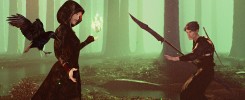METHODOLOGY
Some further Q & A in relation to Methodology and Implementation. I may be getting tired here so the answers may be a little lacking. 😊
How have you approached this project?
- Initial research into the content and approaches of others.
- Deciding on the central premise and stories to represent.
- Listing Characters, places, objects required to achieve the above.
- Iterating through different versions of the above with reflection.
Do you have any design/research principles, guidelines, rules, etc. in place?
As I’ve always followed a agile methodology in my work, I do this as well when it comes to academic projects such at this. Particularly focusing on rapid prototyping.
In terms of the interactions and afforances, I had many discussions with friends and colleagues and subject matter experts on possible mechanisms which could be built “in world” and that were in keeping with the content. So, this was very much user-centric design and ideation.
On the technical side, I had to make crucial decisions early on in terms of scope and optimization of assets (e.g. high, mid, low-poly etc.) to ensure that the end solution would be viable in VR.
What considerations (targets, practical aspects, ethics, how would people engage with your project etc.) do you need to take into account?
I am very conscious that these stories are treated with reverence by many. So, I consulted subject matter experts and always distinguish what I am doing as being “inspired by” these stories. I am not claiming the end-product will be a definitive version of these stories. Which would be impossible as there are so many versions of spoken word stories pertaining to myth, particularly in Ireland.
Voice-cloning comes with its own set of ethics. So, I’ve ensured where voices have been cloned it’s with permission. Similarly, for other recordings, I have sought and obtained specific approvals.
As regards how people would initial engage with this content or be drawn to it, there are two main user journeys into the content as I see it:
- People from or connected to Ireland who know these myths and legends and would be keen to see these stories realised in another medium.
- Those who know key characters events from popular culture (e.g. gaming / Cú Chulainn) and want to learn more about their background.
See “Irish mythology in popular culture“.
Naturally in terms of accessibility there are considerations, including subtitles, cues from the AI driven guide character, and textual cues that will appear embedded (as if through magic) into elements in the world.
What constraints are there on you/the project (if any)?
Time, always time. Also, the number of entangled characters, places, events in these stories. Thus, I found Pádraig Mac Carron and Ralph Kenna’s 2013, “Network Analysis of Beowulf, the Iliad and theTáin Bó Cúailnge” useful in defining the key characters.
How will you evaluate your work?
Probably harshly. 😊 By the time I’m finished anything I always want to remake it. Nonetheless I will use the reflective models and visual analysis frameworks presented throughout the course. Additionally, I will invite others to give their structured feedback on the finished VR experience.
Implementation
What is your plan for implementing your project (design and/or research)?
Think I covered this, well underway. The plan now is to finish the core interactions and characters and move on to enhancing the aesthetics and animations.
What alternatives have you considered (if any)? What are their strengths/weaknesses?
Whether to use voice cloning entirely or depend more on recorded audio (not for purpose) was a decision I had to make.
Voice cloning solutions really killed earlier iterations of the project due to either the lack of SSML (and limitations of SSML) support with cloned voices, or the lack of existing voice synthesis models with Irish accents.
It all lead to immersion in VR being ruined as instead of an enigmatic storyteller, the voice clone sounded like a depressed robot. So I had to switch to a greater focus on recorded audio, which in a way opened up a whole new world of potential content. E.g. realising podcast / audiobook based stories in VR.
Working from your methodology, (how) might things change? Why?
I may have to limit characters and the creation of extra models.
My backup plan here is to use the fire (a consistent feature of all environments where the storyteller exists) to represent aspects of the story using particle effects and animated sprites to make the fire represent, in an abstract sense, parts of the story, thus saving time on more complex character animations.
What needs to be done next?
- Finish modelling. This is nearly done. Both environments are “complete” (subject to tweaks, as are many elements / object and characters.
- Finish the VR interactions (affordances / portals to other stories)
- Add / produce some audio for the story guide responses (driven via Watson AI assistant). In this case, the guide will probably be The Morrígan character.
- Include the audio of the storyteller / synch animations. I have a timeline script setup for the linear pieces of narrative.
- Tweak all animations, lighting etc. Focus on all the subtitles of presence and style.
- Oh, and write the report. 😀


